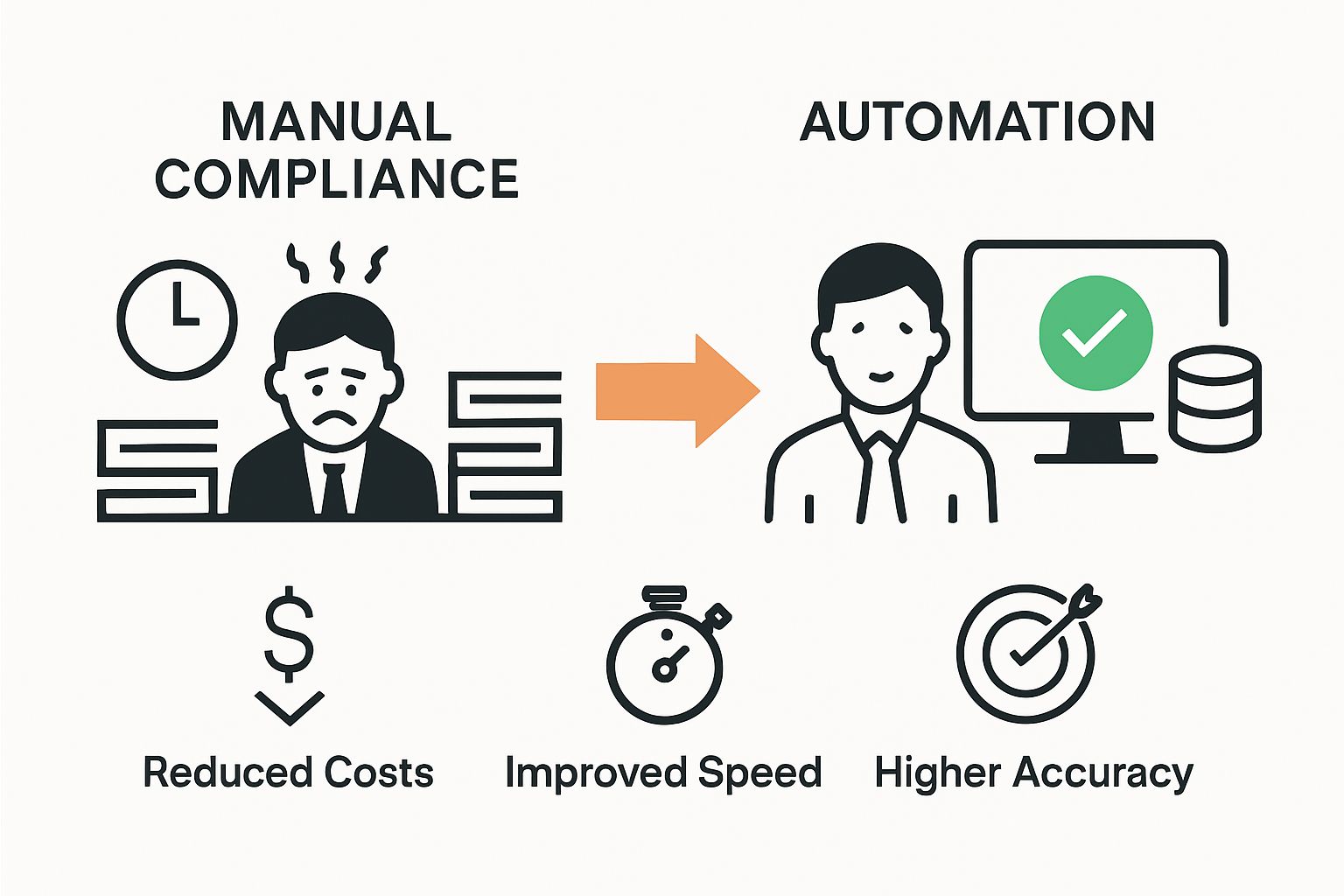14.10.25
Understanding Insurance Compliance Automation Explained

Insurance companies face regulations that change faster than ever and one mistake can cost millions. Research shows organizations using compliance automation technologies can reduce operational risk by up to 45 percent. Sounds complicated or expensive, right? Actually, the most surprising part is how these systems turn compliance from a dreaded chore into a driver for innovation and growth.
Table of Contents
- What Is Insurance Compliance Automation?
- Why Is Insurance Compliance Important?
- Key Concepts In Compliance Automation
- How Insurance Compliance Automation Works
- Real-World Applications Of Compliance Automation
Quick Summary
| Takeaway | Explanation |
|---|---|
| Implement automation to enhance compliance efficiency | Automation streamlines regulatory processes and reduces human error, allowing for more accurate compliance management. |
| Proactively manage risks with intelligent systems | Advanced algorithms help identify potential compliance issues before they escalate, ensuring timely intervention and mitigation of risks. |
| Prioritize compliance to avoid financial penalties | Strong compliance frameworks significantly reduce costs associated with non-compliance, protecting organizations from legal and financial repercussions. |
| Leverage real-time tracking for updated regulations | Continuous monitoring of changing regulations helps maintain compliance and avoids potential lapses in adherence to legal requirements. |
| Transform compliance from cost center to asset | By viewing compliance as a strategic advantage, insurers can focus resources on innovation and customer experience improvements. |
What is Insurance Compliance Automation?
Insurance compliance automation represents a sophisticated technological approach that integrates advanced software solutions to streamline regulatory adherence, risk management, and operational processes within insurance organizations. This innovative strategy transforms traditional manual compliance workflows by leveraging digital technologies to ensure accuracy, efficiency, and consistent regulatory alignment.
Core Components of Insurance Compliance Automation
At its fundamental level, insurance compliance automation encompasses several critical technological capabilities designed to simplify complex regulatory requirements. These systems utilize intelligent software platforms that can automatically monitor, validate, and report on regulatory standards across multiple operational domains.
The table below summarizes the core technological components that make up an insurance compliance automation system, helping clarify their specific functions and contributions.
| Component | Description |
|---|---|
| Automated Document Verification | Digitally reviews and validates documents to ensure regulatory accuracy |
| Real-Time Regulatory Tracking | Continuously monitors evolving laws and standards for instant updates |
| Integrated Risk Assessment Protocols | Identifies, assesses, and mitigates risk factors using intelligent algorithms |
| Comprehensive Reporting & Audit Trails | Generates thorough, traceable reports for audits and compliance checks |
Key technological capabilities include:
- Automated document verification and management systems
- Real-time regulatory tracking and updates
- Integrated risk assessment and mitigation protocols
- Comprehensive reporting and audit trail generation
Strategic Implementation and Benefits
By implementing insurance compliance automation, organizations can address multiple challenges simultaneously. Learn more about embracing compliance through next-generation platforms that transform traditional regulatory management approaches.
According to McKinsey & Company research, organizations utilizing advanced compliance automation technologies can reduce operational risks by up to 45% while simultaneously decreasing compliance-related expenses.
 The strategic integration of these technologies enables insurance companies to shift from reactive to proactive regulatory management, creating more resilient and adaptable operational frameworks.
The strategic integration of these technologies enables insurance companies to shift from reactive to proactive regulatory management, creating more resilient and adaptable operational frameworks.
The ultimate goal of insurance compliance automation extends beyond mere technological implementation. It represents a holistic approach to reimagining regulatory adherence as a strategic advantage rather than a mandatory administrative burden. By transforming compliance from a cost center to a value-generating function, insurers can redirect resources toward innovation, customer experience, and strategic growth initiatives.
Why is Insurance Compliance Important?
Insurance compliance is critical for maintaining the integrity, stability, and trustworthiness of the insurance ecosystem. It serves as a fundamental mechanism that protects stakeholders, ensures fair practices, and mitigates potential financial and legal risks across the entire insurance value chain.
Legal and Financial Protection
Compliance is not merely a regulatory requirement but a comprehensive risk management strategy. Insurance organizations that prioritize compliance protect themselves from substantial legal and financial penalties. These potential risks include significant monetary fines, legal sanctions, and reputational damage that could fundamentally undermine an organization’s market standing.
To clarify the key protective facets of legal and financial compliance in insurance, the following table outlines each main aspect alongside its specific focus area.
| Protective Aspect | Focus Area |
|---|---|
| Fraud Prevention | Detecting and stopping fraudulent activity and misrepresentation |
| Data & Privacy Safeguards | Securing customer information and ensuring privacy rights |
| Financial Reporting Accuracy | Enhancing transparency and reliability in official records |
| Ethical Business Practices | Upholding integrity and responsible conduct throughout operations |
Key protective aspects include:
- Preventing fraudulent activities and misrepresentation
- Safeguarding customer data and privacy rights
- Ensuring accurate financial reporting and transparency
- Maintaining ethical business practices
Regulatory Landscape and Industry Standards
Explore the top challenges facing the insurance industry and understand how compliance serves as a critical mechanism for addressing complex regulatory environments. According to Deloitte research, the average cost of non-compliance is 2.71 times higher than the cost of maintaining robust compliance programs. This stark financial reality underscores the importance of proactive regulatory adherence.
Compliance frameworks are dynamic, constantly evolving to address emerging risks, technological advancements, and changing market conditions. Insurance organizations must remain agile, continuously updating their compliance strategies to align with the latest regulatory requirements and industry best practices.
Beyond financial considerations, insurance compliance represents a commitment to ethical business conduct, customer protection, and maintaining the overall health of the financial services ecosystem. By establishing rigorous compliance protocols, insurers demonstrate their dedication to transparency, accountability, and responsible business practices.
Key Concepts in Compliance Automation
Compliance automation represents a sophisticated intersection of technology, regulatory understanding, and strategic risk management. By integrating advanced digital technologies, insurance organizations can transform traditional compliance approaches into intelligent, proactive systems that anticipate and address regulatory challenges.
Core Technological Foundations
Artificial intelligence and machine learning form the backbone of modern compliance automation technologies. These intelligent systems can analyze complex regulatory landscapes, identify potential risks, and generate predictive insights that enable more strategic decision making. Learn more about automation in P&C insurance to understand the transformative potential of these technologies.
Key technological components include:
- Natural language processing for document analysis
- Predictive risk assessment algorithms
- Real-time monitoring and alert systems
- Advanced data integration and management platforms
Regulatory Intelligence and Adaptive Frameworks
According to Gartner research, compliance automation is not a static process but a dynamic ecosystem that continuously evolves. Successful implementations rely on adaptive frameworks that can quickly respond to changing regulatory requirements, technological advancements, and emerging industry standards.
These intelligent systems go beyond traditional rule-based compliance approaches. They leverage sophisticated data analytics, machine learning algorithms, and comprehensive regulatory databases to create proactive compliance strategies that anticipate potential risks and regulatory shifts before they become critical challenges.
By embracing these advanced technological concepts, insurance organizations can transform compliance from a reactive administrative function into a strategic asset that drives organizational resilience, efficiency, and competitive advantage.
How Insurance Compliance Automation Works
Insurance compliance automation operates through a sophisticated, multilayered technological ecosystem that transforms complex regulatory requirements into streamlined, intelligent processes. By integrating advanced technologies, these systems create a comprehensive approach to managing regulatory adherence and risk mitigation.
Data Collection and Integration
Automated data gathering represents the critical first stage of compliance automation. These systems simultaneously collect information from multiple sources, including internal databases, external regulatory repositories, and real-time documentation streams. Check out our insurance process checklist to understand the foundational steps in creating robust compliance frameworks.
Key data integration capabilities include:
- Centralized document repository management
- Cross-platform information synchronization
- Automated data validation mechanisms
- Secure information transfer protocols
Intelligent Analysis and Risk Assessment
According to PwC research, compliance automation systems utilize advanced algorithms to perform complex risk assessments and regulatory evaluations. Machine learning models continuously analyze collected data, identifying potential compliance gaps, predicting regulatory risks, and generating comprehensive risk profiles with unprecedented accuracy.
These intelligent systems employ sophisticated techniques such as natural language processing, predictive analytics, and anomaly detection to transform raw data into actionable insights. By comparing incoming information against extensive regulatory databases, the automation platforms can instantly flag potential compliance issues, recommend corrective actions, and generate detailed audit trails.

The dynamic nature of these systems allows for real-time monitoring and adaptive response, enabling insurance organizations to maintain continuous compliance while reducing manual intervention and operational complexity. Through intelligent automation, insurers can transition from reactive compliance management to a proactive, strategic approach that anticipates and mitigates potential regulatory challenges before they emerge.
Real-World Applications of Compliance Automation
Compliance automation has transformed from a theoretical concept to a practical necessity across multiple insurance domains. By implementing sophisticated technological solutions, insurance organizations can address complex regulatory challenges while enhancing operational efficiency and risk management strategies.
Regulatory Reporting and Documentation
Automated compliance platforms revolutionize how insurance organizations manage regulatory reporting requirements. Explore claims automation techniques to understand how technology streamlines complex operational processes. These systems automatically generate comprehensive reports, ensuring accuracy and consistency across multiple regulatory frameworks.
Key reporting applications include:
- Automated generation of regulatory compliance documents
- Real-time tracking of changing regulatory requirements
- Comprehensive audit trail maintenance
- Instant compliance status reporting
Risk Management and Fraud Detection
According to Deloitte’s financial services research, compliance automation dramatically enhances an organization’s ability to detect and prevent potential fraudulent activities. Advanced machine learning algorithms can analyze vast datasets, identifying subtle patterns and anomalies that traditional manual review processes might overlook.
These intelligent systems provide insurance organizations with unprecedented capabilities to monitor transactions, validate customer information, and flag potential compliance risks before they escalate. By integrating multiple data sources and utilizing predictive analytics, compliance automation platforms create a proactive defense mechanism against regulatory violations and financial misconduct.
The practical implementation of compliance automation demonstrates its transformative potential. Insurance organizations can now transition from reactive, resource-intensive compliance management to a strategic, intelligence-driven approach that reduces operational risks, minimizes financial penalties, and creates a more resilient regulatory environment.
Ready to Simplify Insurance Compliance?
Are manual compliance tasks leaving your team overwhelmed or anxious about regulatory changes? As you learned in this article, compliance automation is not just about software. It is a complete transformation of how your organization handles risk, reporting, and regulatory demands. With property and casualty insurers facing increasing complexity and the need for real-time data, finding a secure and scalable core platform is more important than ever. IBSuite is built to help you move beyond spreadsheets and slow workflows. It connects sales, policy administration, claims, billing, and regulatory tasks into one seamless experience. This keeps your compliance up-to-date without draining your resources or slowing down innovation.
If your goal is to free your staff from repetitive checks, ensure audit trails, and launch new products faster with full confidence in regulatory support, now is the perfect time to see how Insurance Business Applications can help you. Experience IBSuite’s end-to-end automation and discover how easy it can be to stay ahead of compliance demands. Schedule your personalized demo today and put compliance automation to work for your business.
Frequently Asked Questions
What is insurance compliance automation?
Insurance compliance automation refers to the use of advanced software solutions to streamline regulatory adherence within insurance organizations. To understand its impact, review how these systems can shift compliance from being a reactive task to a proactive strategy.
How does insurance compliance automation reduce operational risks?
Insurance compliance automation can decrease operational risks by up to 45% by using intelligent systems to monitor and address compliance gaps in real-time. To implement this effectively, consider integrating automated risk assessment and reporting mechanisms into your operational framework.
What are the key components of an effective compliance automation system?
An effective compliance automation system includes automated document verification, real-time regulatory updates, and comprehensive audit trails. Begin by evaluating your current processes and identifying areas where these components can be integrated to improve efficiency and accuracy.
How can my organization benefit from implementing compliance automation?
Implementing compliance automation can help streamline your regulatory processes, reduce compliance-related expenses, and improve overall efficiency. Start by conducting a cost-benefit analysis to see how automation can transform your compliance function into a value-generating part of your organization.
What steps are involved in setting up a compliance automation system?
Setting up a compliance automation system typically involves data collection, integration of advanced technologies, and configuring automated workflows. Follow a structured plan that includes identifying data sources, selecting appropriate software, and training your team to utilize these tools effectively.
How does compliance automation enhance fraud detection in insurance?
Compliance automation enhances fraud detection by leveraging advanced algorithms to analyze large datasets and identify anomalies. To improve your fraud detection capabilities, implement machine learning models that continuously monitor transactions and flag potential risks in real-time.
Recommended
- Automation and Artificial Intelligence in P&C Insurance – Digital Insurance Platform | IBSuite Insurance Software | Modern Insurance System
- 7 Steps to a Successful Insurance Process Checklist – Digital Insurance Platform | IBSuite Insurance Software | Modern Insurance System
- Embracing Compliance through Next-Generation Insurance Platforms – Digital Insurance Platform | IBSuite Insurance Software | Modern Insurance System
- Understanding Insurance Business Architecture for Insurers – Digital Insurance Platform | IBSuite Insurance Software | Modern Insurance System
- What is Safe Instagram Automation? Understanding the Basics
- 7 Reasons Why Rental Agents Need Insurance Knowledge – Rental Income Insurance